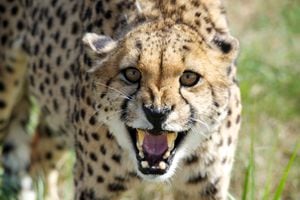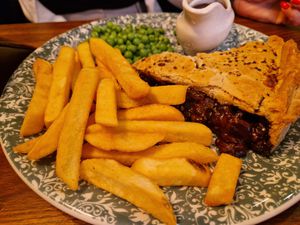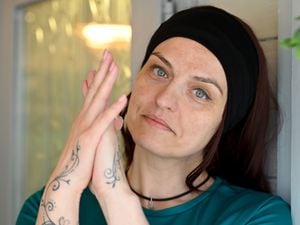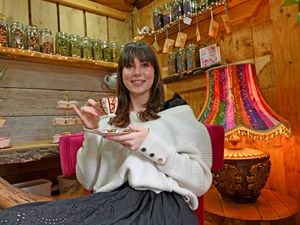It’s humbling to be in their world: What it's like to be a wildlife photographer
From walking with wild cheetahs to a too-close-for-comfort encounter with a puff adder, life is never dull for photographer Simon Palmer.

After 25 years of working in IT, he decided to leave the industry behind to pursue his true love.
Armed with his trusty camera, he worked initially as a concert photographer for bands such as Madness, Marillion and Simple Minds.
He then moved into equine photography, meeting his wife Sue in the process and working at events such as Horse of the Year and also with world-renowned horse trainer and Hollywood stuntman Monty Roberts.
But one of his biggest passions is helping conservation charity AfriCat, which has seen him travel to Namibia to see their work, rescuing and returning big cats to the wild, first-hand.
Since 2011, he has been volunteering his time and helping to raise vital funds towards its mission to secure the long-term survival of the country’s predators in their natural habitat.
It’s a cause that is very close to his heart and he helps to raise awareness of AfriCat’s as well as documenting the charity’s activities and research.
“It is a fantastic charity because if we don’t do something and do it soon we will lose these incredible animals.
“I have a five-year-old son, Philip, and he wants to see cheetahs in the wild but there are only believed to be around 7,300 left in the wild – that’s it.
“These animals seem so distant to us but cheetahs, lions, leopards, hyenas and vultures all play a key role in the eco-environment,” explains Simon, who began taking photographs when he was just 16 years old.
“After 25 years in IT lining other people’s pockets, I wanted to give something back. I take photographs of the animals that are sent to people that are paying money to sponsor the animals.
“I also go out to Namibia to photograph the annual health checks they have to do on all of the animals.
“I also raise money for AfriCat in the UK by selling my photos and calendars,” adds the 52-year-old.
There have been many memorable moments from his trips to Namibia.
“I have been so lucky because I’ve walked with wild cheetahs. To be tolerated by this wild animal is always incredible.
“I always very conscious that I’m in their world and they are allowing me to be there. They have to be respected. It’s very humbling. When you go out in the wild you realise you are part of much bigger picture,” says Simon, who lives with his wife Sue, who is an equine physiotherapist, and son Philip in Stafford.
But there have been a few encounters that have left him with even greater respect for these big cats.
“I was taking a picture of a cheetah sat under a tree in one of the enclosures. I was using a zoom lens so I was close but not too close.
“Suddenly, someone told me to step back and look up. There was a female leopard sat in the tree starring me – obviously wondering if a free meal had wandered in.
“Another time I was on the back of a Land Rover taking pictures of a lioness sat on an outcrop of rocks.
“She then started stalking me and she was close enough that if she really wanted to she could have jumped from where she was on to the top of the Land Rover. It was time to move!”
While he also feels very lucky after getting rather close to a puff adder – a venomous African viper snake – and living to tell the tale.
“I hadn’t even seen it on the ground and I stepped right over it.
“I was in striking distance and if it had struck, that would have been it for me. Thankfully, it was still really dozy and hadn’t seen me. It was a close call,” explains Simon.
Photography is all about story-telling and sparking a reaction in his audience, he tells us.
“It’s about challenging people’s perceptions. Photographs are a great leveller in people. You can have people from all different walks of life look at a picture and it will make them all feel something different,” explains Simon.
He also works with The Rare Breeds Survival Trust, helping to raise money for its work with heavy horses.
“We have breeds of horses that are on the endangered species list. We’ve had animals that in the past have had important jobs like pulling canal boats in the Black Country.
“But now they are no longer needed because we’ve moved on and they are disappearing. It’s so important that this doesn’t happen.
“The Rare Breeds Survival Trust has launched a gene bank to save some of the large heavy horses who are critically endangered,” explains Simon who is also chairman for a fundraising group for Staffordshire Wildlife Trust.
His advice for anyone wanting to pursue wildlife photography includes getting to grips with their camera and understanding the subject.
“Know the basics and band yourself from using the auto or program settings.
“Understand what the shutter does and about aperture and the ISO and they relate to each other,” recommends Simon
“Also take time to really understand the subject, if it’s wildlife, research when they are likely to be more active but also be aware that some species are protected so make sure you know what the laws are.”
* To buy a calendar or more information about AfriCat see www.cheetahworld.com





